| Grape harvesting |
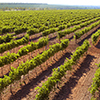
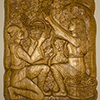 |
Vineyards of the Tiraspol Winery & Distillery KVINT are located in the terroirs of Kamenka, Rashkovo and Doibani, well-protected from the winds by the Poyany and Kalagur woods.
The total area of our vineyards is 2000 hectares planted on different kinds of soil, such as sandy soils with high content of calcium, those rich in limestone, southern black soil. Soil composition has great influence on the properties of cultivated grapes, and such a variety of species allows us to obtain unique organoleptic qualities of wine.
The grape berries contain numerous useful elements and micro-elements: minerals, bio-active substances, amino acids, sugars and vitamins. Judging by the sugar content, one can determine the ripeness of grapes and schedule the right timing for the harvesting operations. Elite varieties are still picked manually, like centuries ago. Fine and collection wines will be created from these grapes. However, apart from handpicking the rest of the process is fully automatic. |
| Processing |
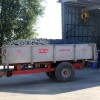 |
Harvesting and transportation of grapes to the processing lines are followed by crushing and destemming. The aim of crushing process is a destruction of grape berries in order to extract juice. Use of roller crushers excludes the damaging of seeds and abrasion of stems during the process. The stems are removed from the grape clusters on the horizontal destemmer. This operation is necessary to reduce the amount of tannins in wine material and protect it from the bad taste and rudeness. The crushed grapes are pumped into the tank, where, if needed, maceration is performed, i.e. the crushed grapes are infused on skins, with or without dry ice (as a production engineer decides). When the maceration is over, the crushed grapes proceed to the pneumatic wine press. |
| Preparation of white wine material |
| Pressing |
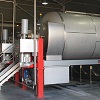 |
The pneumatic wine press is filled with crushed grapes. Pneumatic presses are equipped with rubber membrane. Compressed air controlled by time is supplied in 3 stages into the press, inflating its membrane and thus squeezing juice from the crushed grapes. |
| Settling |
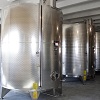 |
The main way of juice clarification is its settling and decanting of the clarified parts. Settling enables to remove turbidity, partially microorganisms, oxidative enzymes and suspended particles of grape berries, which could cause negative effect on taste qualities of wine. As a rule, wine made from settled juice features pronounced aroma, harmonious taste, clarity and increased stability. |
| Fermentation |
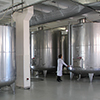 |
Clarified juice is transferred to fermentation stage. Fermentation of wine materials takes place in special tanks, the so-called fermenters, which can hold from 5 to 60 thousand liters of grape must. An up-to-date equipment enables to strictly control every tiny detail in the behavior of fermenting juice through the entire process of its transformation into wine. For instance, an operator can decrease the fermentation temperature with a decimal accuracy in order to select from the grape aroma only the purest fruity and floral notes. |
| Transfers |
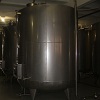 |
When wine material is clarified, which occurs in 4-6 weeks period after the complete stop of fermentation, it is necessary to remove wine material from lees (the first transfer). In 1-1.5 months the second transfer takes place, wine material is sent to storage and treatment, including glueing and cold treatment to make wines stable and clear. |
| Preparation of rosé and red wine material |
Fermentation on skins
|
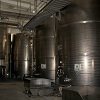 |
Vinificators are filled with crushed grapes with skins up to 80-85% of their capacity. In the process of fermentation the fermenting juice is periodically pumped over from the lower part of the tank to the top part in order to improve the extraction of coloring and phenolic substances. Such stirring is repeated 3-4 times per day. When the wine material through such fermentation obtains typical color, astringency and fullness, it is separated from the solids by means of pressing. |
| Pressing |
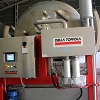 |
The pneumatic wine press is filled with crushed grapes. Pneumatic presses are equipped with rubber membrane. Compressed air controlled by time is supplied in 3 stages into the press, inflating its membrane and thus squeezing juice from the crushed grapes. |
| Transfers |
 |
8-10 days after the complete stop of the process of fermentation, the wine material is taken off from the lees (the first transfer) and put into separate tanks for 30-45-days rest, after which the second transfer is done. Wine material is sent to storage and treatment, including glueing and cold treatment to make wines stable and clear. |
| Cold treatment |
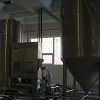 |
Separation of low-soluble salts of tartaric acid from wine is achieved by cold treatment: for table wines the temperature is close to freezing point –3-4°С, for fortified wines the temperature is –6-8°С. In the process of the treatment unstable protein substances coagulate; extractive, phenolic, coloring and pectic substances precipitate out; and crystallization of tartar occurs. During deposition of these substances, suspended particles, yeasts, bacteria and other micro-organisms are taken out of wine, resulting in improvement of physico-chemical and microbiological stability of wine. |
| Ageing |
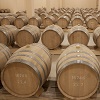 |
Similar to eaux-de-vie, red wines are aged in oak barrels for not less than 12 months. According to the production technology, constant temperature and humidity are kept in the cellars where wines mature. Multitude of grape varieties, favorable conditions of ageing including temperature control, humidity, competently chosen barrels and daily care – any of these components contribute to the formation of taste accents and aromatic nuances. |
| Blending |
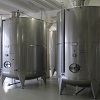 |
This is a technological step of wine production process, which constitutes mixing of the certain ratio of various wine materials to obtain blended wines, to provide typical features of wine, to guarantee uniformity of organoleptic properties of wines of different vintage. The quantity of each wine material with known parameters is calculated in advance to prepare blending with desired conditions. Masters make several experimental blends in order to choose wine materials correctly and to determine the quality of the resulting mixture. After mixing procedure the experimental blends are left for rest for a few days. Then the sensory evaluation is carried out and the best sample is chosen – it will be used in production. |
| Rest |
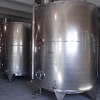 |
The freshly prepared blend of wine is characterized by misbalanced bouquet and taste, due to disturbance of equilibrium of the components. To avoid this, every blended wine is put for rest for 10 days. |
| Microfiltration |
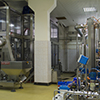 |
The microfiltration plant, due to membrane filtration, makes it possible to heighten the microbial stability of the wine, ensuring its problem-free storage in bottle and expanding its life-span. Distinguishing features of the microfiltration plant are options including dosing of rectified concentrated must in a continuous stream and deoxygenating of wine in a stream. Apart from the finest filtration, the plant adds inert gases (nitrogen, carbon dioxide) into wine, thus increasing the shelf-life of the product and improving its quality. |
| Bottling |
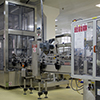 |
Wines are bottled at the special line. Cold bottling of wine is the most advanced way to achieve stability of wine, since the use of this method excludes introduction of any extraneous substances, wine composition remains unchanged, its bouquet and taste are kept preserved. Immediately before bottling the wine passes through a cascade of membrane filters, and undergoes a full cycle of treatment in order to improve stability against all kinds of turbidity. To obtain a sterile wine it is necessary that all equipment is sterile.
Bottling is one of the main stages in a cycle of production of top-quality drinks. Quality is above all, therefore the process of wines and spirits creation is controlled at all stages by accurate instruments of KVINT laboratory which is accredited in Moldova for conformity to International standard ISO 17025:2006. |